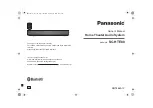
11
Here are some other placement tips:
• Avoid placing loudspeakers in the corners of a room.
This increases the low-frequency output and can cause
the sound to be muddy and indistinct.
• Avoid placing loudspeakers against a wall. This, too,
increases the low frequency output, though not as
much as corner placement. However, if you do need to
reinforce the low frequencies, this is a good way to do it.
• Avoid placing the active speakers directly on a hol-
low stage floor. A hollow stage can resonate at certain
frequencies, causing peaks and dips in the frequency
response of the room. It’s better to place the active
speakers on a sturdy table or tripod stands.
• Position the active speakers so the high-frequency driv-
ers are two to four feet above ear level for the audience
(make allowances for a standing/dancing in the aisles
audience). High frequencies are highly directional and
tend to be absorbed much easier than lower frequen-
cies. By providing direct line-of-sight from the active
speakers to the audience, you increase the overall
brightness and intelligibility of the sound system.
• Highly reverberant rooms, like many gymnasiums and
auditoriums, are a nightmare for sound system intel-
ligibility. Multiple reflections off the hard walls, ceiling,
and floor play havoc with the sound. Depending on the
situation, you may be able to take some steps to mini-
mize the reflections, such as putting carpeting on the
floors, closing draperies to cover large glass windows,
or hanging tapestries or other materials on the walls to
absorb some of the sound.
However, in most cases, these remedies are not possible
or practical. So what do you do? Making the sound
system louder generally doesn’t work because the
reflections become louder, too. The best approach is to
provide as much direct sound coverage to the audience
as possible. The farther away you are from the speaker,
the more prominent will be the reflected sound.
Use more speakers strategically placed so they are closer
to the back of the audience. If the distance between the
front and back speakers is more than about 100 feet, you
should use a delay processor to time-align the sound.
(Since sound travels about 1 foot per millisecond, it
takes about 1/10 of a second to travel 100 feet).
SRM450
Rigging Points
Both Sides
Back
Bottom
Top
Pole
Mount
RIGGING
The SRM450v cabinets are fitted with ten rigging points
as shown in the diagram below. These are M10 inserts. M10
threaded eyebolts (M10 x 1.5 mm x 0 mm) are available to
fit these inserts (PA-A1 Eyebolts).
WARNING:
Never attempt to suspend
the SRM450v active speakers by their
handles. If you want to suspend them,
use the rigging points only. Consult a
professional rigger or structural engi-
neer prior to suspending loudspeakers from a structure not
intended for that use. Always know the working load limit
of the structure supporting the loudspeaker array. Always
make sure that the rigging hardware minimum rating is at
least five times the actual load.
If you are hanging them in an inacces-
sible place, such as over a lion’s cage,
make sure that you first complete the
sound check and set the SRM450v
LEVEL correctly. Also set the TIMED
TURNOFF switch if you want the SRM450v to turn on
when there is a signal present. It will also turn off after
three or more minutes of silence.






































